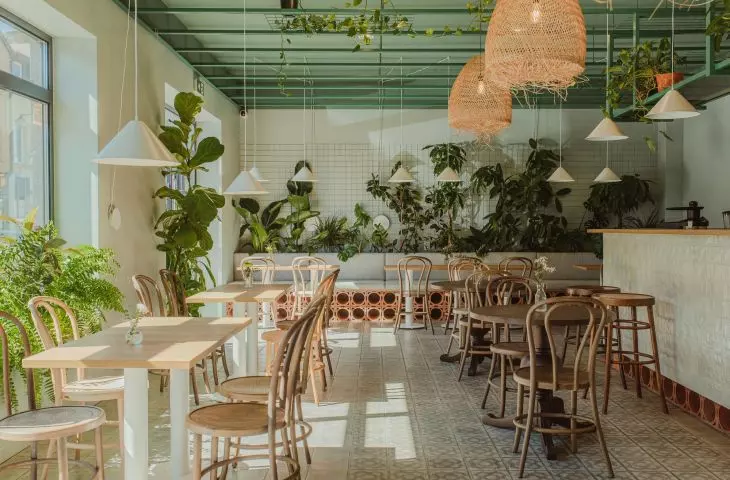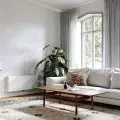Abundant greenery, plants wrapping the walls and ceiling, ceramic hollow tiles in a burnt sienna hue, large rattan lamp shades, graphic floral patterns and warm southern daylight, this is how the interior of Bistra Zagajnik in Radomsko can be described in a nutshell. Madde, a Wroclaw-based design studio, is responsible for the design of this green establishment. We talk to one of the authors - Maja Górowska- about the work, inspiration and creating a homey atmosphere.
Bistro Zagajnik is full of plants
Photo: Maja Bułkowska © Madde
Plants in the interior of the bistro were the main theme of the project by Madde from the beginning. The designers installed a steel structure under the green ceiling, on which they placed pots with climbing plants. Grates for climbing plants also appeared on the walls, at which upholstered benches stand. Their base was made of ceramic bricks. The bricks also form the base of the bar, covered with white tiles with a non-uniform surface texture and a pearlescent finish. Together with the rattan lamp shades, the hollow blocks gave the place a slightly exotic atmosphere, to the author reminiscent of trips to India and Morocco.
Beech wood chairs on the seats have floral, openwork compositions
Photo: Maja Bulkowska © Madde
The room is furnished with chairs, locally manufactured by the Radom-based Fameg. They are classic Thonet designs - made of beech wood, with bent back elements. The floral compositions on the seats of the chairs allude to the motif appearing on the floor. In the warm light of the midday sun, their translucency creates additional patterns, painted with chiaroscuro on the floor.
The bar was covered with white tiles, while the floor was tiled with a floral motif
Photo: Maja Bulkowska © Madde
interview with Maja Górowska of Madde
Dobrawa: What is the history of Bistra Zagajnik?
Maja Górowska: Bistro Zagajnik is the second dining establishment of the owners of Radom's Forest, the design of which was the responsibility of Karolina Koryniowska, now part of the Madde design team. The Forest, however, is a slightly more formal venue for large family and business meetings. The grove was intended to be more casual, in the nature of a bistro, not a restaurant.
The grove was meant to be more casual, in the nature of a bistro, not a restaurant
Photo: Maja Bulkowska © Madde
Dobrawa: What was the main design inspiration, where did you start the project? Did the investor set any special requirements?
Maja: We started the project, as always, with an interview with the investor, who in this case - after her experience in the first premises - defined her functional requirements quite precisely. She also shared her inspirations, which included abundant vegetation and greenery. This is where it all started, and it was probably the plants, of which we are big supporters in interiors, that set the further direction of the project.
The authors wanted to create a warm, homely atmosphere
Photo: Maja Bułkowska © Madde
Dobrawa: What kind of atmosphere did you want to achieve by choosing such materials, colors and, above all, lush vegetation?
Maja: The atmosphere of the Grove was to be warm and homely, like the bread they sell in the bistro, which they bake on site. It was also to be a place that, with its character, would naturally attract guests, while not scaring them away with an overly elegant or obtrusive design. In big cities, we are more accustomed to heavily stylized establishments. Even so, some of them cause guests looking through the glass to decide not to go inside because the establishment gives the impression of being expensive. This is the effect we definitely wanted to avoid. The materials we used are a combination of austere structures - such as ceramic blocks, concrete tiles and steel trusses - with warmer homey atmospheres - plants, greenery and wood. The chairs, manufactured at the local Fameg factory, were an obvious choice, further embedding the Zagajnik in the local context.
Bistra Zagajnik's projection
© Madde
Dobrawa: Who are the visitors to Zagajnik and how do you expect them to feel here?
Maja: The cross-section of visitors to the Zagajnik is very large. You can drop in here for bread or jars of homemade preserves, stop for dumplings for a while, or sit longer - the whole family. But also in the evenings the place is supposed to encourage social gatherings with music in the background. Above all, everyone should feel at ease here.
The biggest design challenge was to convince investors to use hollow blocks
Photo: Maja Bułkowska © Madde
Dobrawa: What was the biggest design challenge, and what are you most proud of?
Maja: We have to admit that both the cooperation with the investors and the implementation itself went exceptionally smoothly, everything was carried out in a nerveless atmosphere. Maybe because this was not our first project carried out together. The investors gave us a lot of freedom in terms of design and choice of materials, in fact there were no changes here from the beginning. We were given a lot of credit and tried to use it well. The biggest challenge, and probably at the same time the one we are most satisfied with, was to convince investors to use non-standard materials. We are, of course, talking about hollow blocks, which had been following us for a long time. We found their form and color very inspiring, and they also play well with the ubiquitous greenery.
Dobrawa: Thank you for the interview.





















































